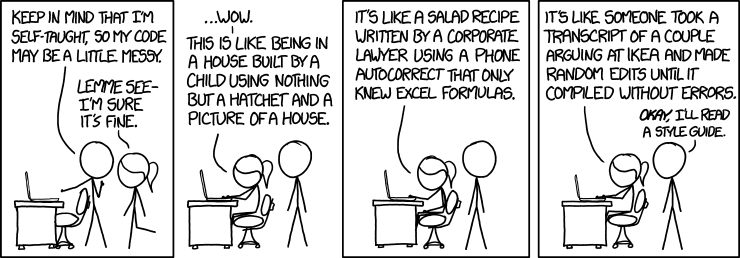/** * CS139 - Programming Fundamentals * Department of Computer Science * James Madison University * @version Spring 2016 */
CS139 Style Guide

Source: https://xkcd.com/1513/
Background
Virtually every organization that does software development has strict guidelines on how to format source code. Here are two examples of widely used Java style guides:
Sun Java Code Conventions (April 1997)
Google Java Style (March 2014)
This course will more or less follow a simplified version of these guidelines. Rather than memorize a long list of rules, you should develop good habits and intuition when it comes to style.
Style Guide
A. Comments
- Every class must contain a Javadoc comment with the following three elements.
-
Every programming assignment must contain the following statement or
must cite any sources used (such as a TA). This code must come
directly beneath the class comment.
/* * References and Acknowledgments: I received no outside help with this * programming assignment * */
OR/* * References and Acknowledgments: TA Glenn helped me with the foo method. * */
- All methods (including
main) must contain an applicable Javadoc comment./** * Overall description of the method goes here. * * @param paramterName describe each input parameter * @param anotherParam use a separate line for each * @return describe the value that this method returns */
- All comments should use normal English spelling and grammar. Phrases are okay.
- In-line Comments must come before the code that they are describing or on the same line.
/** * Overall description of the class goes here. * * @author Your name goes here * @version Due date goes here */
B. Names
- All names should be descriptive and readable.
(
subTotalrather thans,graderather thangrd) - Multiple-word names should use capital letters to separate words.
(
subTotal, notsub_total) - Variable and method names should begin with a lowercase letter, and:
- Variable names should be nouns or noun phrases. (
studentNameorsubTotal) - Method names should be verbs or verb phrases. (
printLineoraddColumn)
- Variable names should be nouns or noun phrases. (
- Class names should begin with a capital letter and use title case. (
HelloWorld) - Constant names should be all caps with an underscore separator. (
PIorINTEREST_RATE)
C. Declarations
- All constants should be named and initialized at the top of the method in which they are used.
- All variables should also be declared at the top of the method, directly after any constant declarations.
- It is strongly recommended (in CS 139) to separate variable declaration and initialization statements.
- There should be at most one variable declaration per line. Comment to the right if the name is not self-explanatory.
final double CENTIMETERS_PER_INCH = 2.54; centimeters = inches * CENTIMETERS_PER_INCH; // NOT inches * 2.54;
Scanner input = new Scanner(System.in); // discouraged Scanner input; input = new Scanner(System.in);
D. Literals
- Numeric literals should be of the correct type for the context in which they are used.
// integer expressions should use integer literals int count; double value; count = 2; value = 2.0; // double expressions should use double literals double x; double y; double average; average = (x + y) / 2.0; // NOT 2, which is an integer
E. Indentation and Whitespace
- Subsections of code should be indented consistently with three spaces. (Four spaces would be more standard. We are using three because that's the default behavior of jGRASP.)
- Always use three space characters, not tab characters, for indentation.
- Statements too long for one line should be indented on subsequent lines.
- There should be a space after cast operators, commas, and //'s.
- Use whitespace to separate logical segments of code. There should be a blank line after variable declarations.
- Binary operators should be separated from their operands by a single space.
(
sum = myGrade + yourGrade;) - One exception is the dot (
.) operator, which should not have space surrounding it. (System.out.println();) - Unary operators should not be separated by a space.
(
myGrade++;)
F. Structure
- Lines should be kept short (< 80 chars). You should be able to see the full line in your text editor.
- All blocks of code (even if one line) should be surrounded by curly braces.
- Left braces must appear on the same line as the structure header.
- If a method returns a value, it should have a single return statement.
- Break statements should not be used except in the case of a switch.
- You must not have any unused variables or constants or lines of code that do nothing (like
a = a;) - You must not have any empty if/else blocks:
if (condition) { // This block is empty. Not OK. } else { System.out.println("Condition not true!"); }